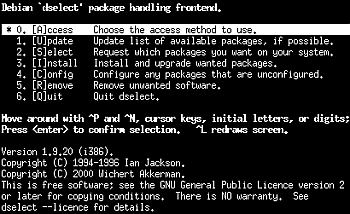apt-get is prolly the tool of choice among most people. To install a package an automatically
meet its dependencies, use apt-get install pkg-name. If there are other packages to be
installed because of dependencies, apt will let you know before downloading them.
If you install a deb without meeting the requirements, or a problem is encountered during install
or removal, very often you won't be able to work with dpkg until the problem is resolved. If
that happens, you can use apt-get -f install, which will work everything out and ask
questions as it goes along.
To remove a package, use apt-get remove pkg-name.
To download the source code of a package, use apt-get source pkg-name. You can even
compile it by using aptget source --build pkg-name.
If you want to clean out hte archives, there are two options. To remove all archives, the
command is apt-get clean. You'll want to do that if you find /var filling up, since
apt-get caches packages when it downloads them. If you want to remove only the old archives,
apt-get autoclean.
To upgrade your system to the newest versions of the packages, do apt-get upgrade
(first perform apt-get update. To upgrade to a new version of debian, it's apt-get
dist-upgrade. It will automatically work out dependencies for packages whose names might
have changed. You may need to run apt-get dist-upgrade a few times till apt-get doesn't
download anything new. This is to work out dependencies and configuration requirements. There's
no way to downgrade.
A few other command-line options are helpful when using ap-get. -d only downloads
archives, but doesn't try to unpack or install them. -s is for simulation; it's good
for situations where you want to see what would happen if you did something, but don't actually
want the operation performed. -y answers yes to all questions and -b tries to
build a source package after downloading it.
apt-get also understands regex. For example:
- apt-get install '.*mame.*'
- apt-get install '^pilot.*'
 dselect is a frontend to dpkg that uses the console based ncurses library for an interface. Most
people prefer apt/dpkg to dselect; even the man page for dselect mentions that the dselect
interface is confusing or even alarming. Running dselect puts you in the main menu that has
various options.
dselect is a frontend to dpkg that uses the console based ncurses library for an interface. Most
people prefer apt/dpkg to dselect; even the man page for dselect mentions that the dselect
interface is confusing or even alarming. Running dselect puts you in the main menu that has
various options.
The first option, "Access", selects how dselect will access the packages you want to install.
It should be straight forward. Most of the time you'll want apt (if you have a net connection) or
cdrom (if you don't).
The next option, "Update" is used to update dselect's knowledge of what packages and package
versions are available. You don't actually need to use the interface to update dselect's knowledge
of the package database. From a command line, you can simply type dselect update and
dselect will update its database without starting the ncurses interface. It'll exit as soon as the
database is updated.
The third option, "Select", lets you choose which packages you want to install or remove.
Unless you run dselect with the "--expert" command line option, immediately after choosing this
option, dselect will display a rather confusing help screen (in fact, I would recommend running
dselect with "--expert" whether you're an expert or not. If you ever want to look at the help
screen, you can always press "?" to view it). To exit out of the help screen and enter the package
selection/deselection screen, press <space>. Now you're ready to select. Here are
some useful keystrokes for the the select/deselect screen:
- /: Search
- \: Repeat the last search
- ?: Brings up the help screen
- d: Scrolls down the package information
- u: Scrolls up the package information
- +: Install or upgrade the currently highlighted package
- -: Remove the currently highlighted package
- =: Leave the currently highlighted package in its current state.
Even the man page claims that dselect doesn't handle "Recommends" very well. It's easy to get into
a situation where dselect undoes what apt-get just did. It's somewhat tyrranical with regard to
what it thinks is a dependency conflict. You can always force the issue, but it's hard getting
past dselect's melodrama. Frankly, I would highly recommend not using dselect. Just pretend it
doesn't exist.
 dselect is a frontend to dpkg that uses the console based ncurses library for an interface. Most
people prefer apt/dpkg to dselect; even the man page for dselect mentions that the dselect
interface is confusing or even alarming. Running dselect puts you in the main menu that has
various options.
dselect is a frontend to dpkg that uses the console based ncurses library for an interface. Most
people prefer apt/dpkg to dselect; even the man page for dselect mentions that the dselect
interface is confusing or even alarming. Running dselect puts you in the main menu that has
various options.